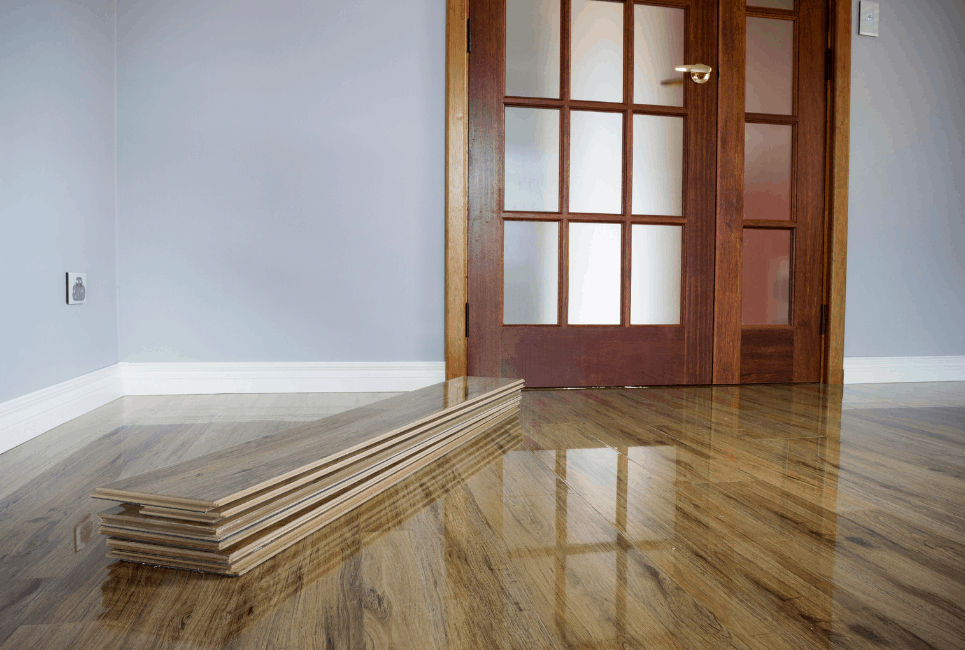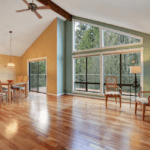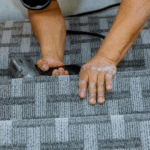- LL Flooring Review: Should You Buy From There? - June 25, 2022
- Grizzly G0771Z Review: Do We Recommend? - June 25, 2022
- Micrometer vs Caliper Compared: Which Measurement Tool Should You Buy? - June 25, 2022
The look and feel of your bedroom or any other room in your home is at least in part determined by the flooring you choose. So, comparing the engineered hardwood vs laminate flooring options can help you make your home’s interior cozier and more elegant.
Besides the aesthetic, flooring also plays an important functional role in preventing flooding or making a room warmer.
The visual appearance, affordability, and durability are some of the reasons why so many homeowners select the engineered hardwood or laminate flooring over hardwood flooring options. However, a broad range of similarities makes choosing between these flooring types a bit confusing.
Our engineered wood vs laminate flooring comparison will provide you with the information you need to determine which flooring type is better suited for your home renovation project.
Also, you should go through our LL Flooring vs Home Depot comparison to find out which retailer offers better flooring solutions and see how to get the most out of your purchase by doing it in the best time of the year..
Main Differences Between the Engineered Hardwood vs Laminate Flooring
The main differences between engineered hardwood vs laminate flooring are:
- Engineered hardwood features a natural wood veneer at the top, whereas Laminate flooring has a photographic and a protective layer at the top
- Engineered wood costs between $5 and $10 per square foot, whereas laminate costs between $2.5 and $4 per square foot
- Most engineered hardwood floors can be sanded and refinished at least once, whereas Laminate flooring can’t be refinished
- Engineered hardwood flooring can last for two or three decades, whereas laminate flooring has to be changed after ten to twenty years
- Engineered hardwood flooring requires more time and skill to install, whereas Laminate flooring is easy to install
Key Specifications
| Engineered hardwood | Laminate flooring | |
| Hardness | Depends on the manufacturer | AC1 to AC5 depending on the model |
| Water resistance | Moderate | Moderate |
| Top layer type | Natural wood veneer | Photographic print and a plastic wear layer |
| Weight | 1.5 to 2.8lbs per square foot | 1 to 1.5lbs per square foot |
| Impact resistance | Good | Excellent |
| Life expectancy | 20 to 30 years | 10 to 20 years |
| Latest price | Check the latest price | Check the latest price |
Examining the features of the engineered hardwood and laminate flooring

Engineered hardwood flooring
Although it is often referred to as fake wood, the engineered hardwood flooring is made from processed wood. Moreover, its top layer features a sheet of natural softwood or hardwood, which further blurs the line between actual and engineered hardwood.
In certain aspects, engineered hardwood is more reliable than the flooring solutions made of unprocessed natural wood, as it doesn’t warp easily or absorb water quickly.
Unlike laminate, engineered hardwood is usually as thick as hardwood flooring, which ensures the planks’ durability and stability. Consequently, engineered hardwood floors don’t flex under pressure like laminate flooring solutions, although they can feel hard when you step on them.
The installation process of this type of flooring depends on the model’s properties, so you can either use a finishing nail gun to fasten them to the surface below or you can glue them to the concrete subfloor.
Go through our Red Oak vs White Oak comparison to find out more about these hardwoods’ differences.
Key features
- A convincing replica of hardwood flooring
- Three-layer structure
- Huge selection of styles and colors
- The top layer is made of natural wood
- An environmentally friendly product that contains 70% of repurposed wood waste
- Moderate water and heat resistance
- Available in different sizes
- Most engineered hardwood flooring can be refinished
Visual appearance
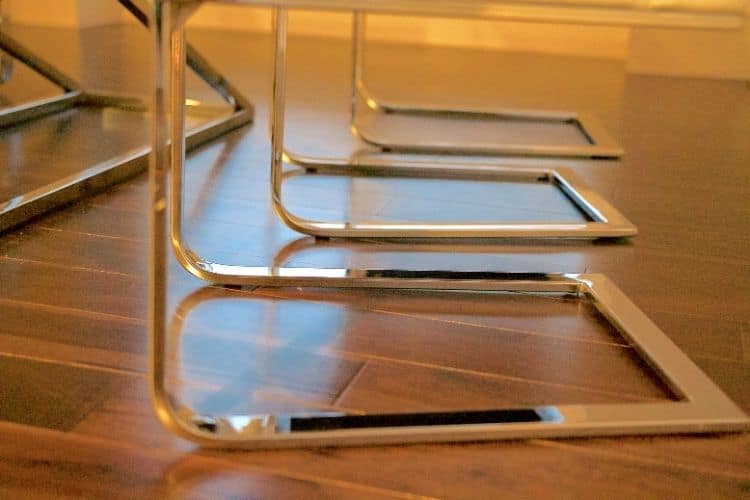
On the surface, the engineered hardwood flooring looks the same as the hardwood flooring. The reason for this is a veneer that sits at the top of all engineered hardwood flooring models. The veneer is made of materials that are commonly used to manufacture hardwood flooring.
As a result, you can get models with top layers made of Brazilian Cherry, Maple, Ironwood, or any other hardwood material. An engineered hardwood plank’s width varies between 2-1/4-inches to 7-inches, while its length can be anywhere between 36 and 48 inches.
However, some manufacturers offer models that don’t have uniform sizes, and you’ll have to use a table saw or a chop saw to adjust the size of planks to the demands of your project.
The process of installing engineered hardwood isn’t much different from the hardwood flooring installation process, and you shouldn’t go through it on your own if you don’t have the necessary experience.
Structure and hardness
Measuring engineered hardwood’s hardness using the Janka scale isn’t possible because its structure is different from flooring options made from solid wood.
The top layer of any engineered hardwood will have the same Janka rating as the material from which it is made, but lower layers are usually much softer. All engineered hardwood flooring options can have three or two layers, depending on which materials were used to make lower layers.
An engineered hardwood plank has three layers, indicating that the two lower layers are made from plywood, while two-layered models feature a high-density fiberboard underneath the top layer.
Wax or water-repellent materials are often added to the core and backing layers to increase the moisture and water resistance of engineered hardwood planks. Despite this, installing this type of flooring in the kitchen or bathroom isn’t advisable as it may swell and warp if it gets soaked with water.
Other noteworthy features
Even though engineered hardwood resists water better than most hardwoods, it still doesn’t perform well in damp and humid conditions. The veneer at the top is treated with a waterproof water sealer that prevents it from absorbing water, but the space between planks is wide enough to allow fluids to seep through and reach the fiberboard or plywood layers.
As a result, exposure to high amounts of water or high levels of humidity in a room can cause the engineered hardwood to warp. This type of flooring isn’t easily affected by direct exposure to sunlight or heat, although sudden temperature changes can cause irreparable damage to it.
Also, this material is quieter than laminate, as its surface doesn’t contain plastic that makes noises every time you step on it.
Reliability
Engineered hardwood floors are a more affordable variation of hardwood flooring options. So, if you’re searching for a flooring solution that has almost identical features to hardwood flooring, you should consider opting for an engineered hardwood floor.
On average, you’ll have to spend between $5 and $10 per square foot meter of engineered hardwood flooring, while premium models can cost up to $15. Despite a relatively steep price, this flooring type is an excellent long-term investment as it can last for up to three decades if it is properly maintained.
However, you should factor in the installation costs when considering engineered hardwood flooring, because the process can be too difficult to complete without professional help.
Check out our guide to the best types of wood flooring for more information about different types of hardwood.
Laminate flooring
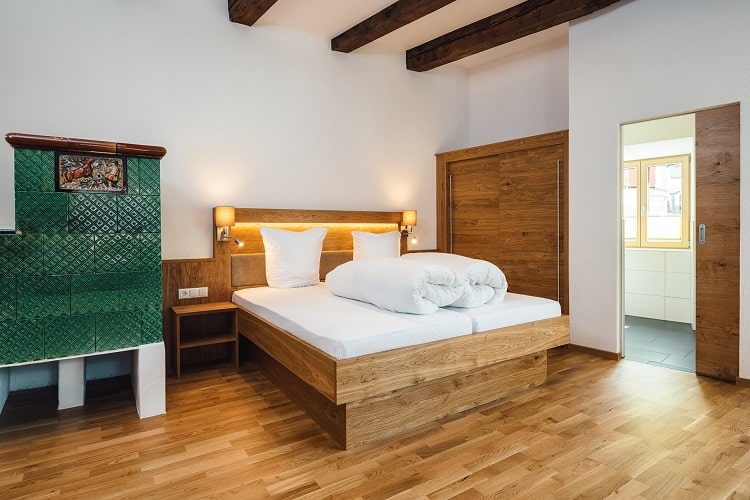
Laminate flooring was introduced to the market in 1984 by a Swedish company under the brand name Pergo. Less than four decades later, laminate is one of the most popular types of flooring that is equally used in residential and commercial settings.
The stunning diversity of available options enables you to fit this type of flooring into any setting, as laminate flooring is available in a broad range of colors and hardness levels. However, most models attempt to replicate the look and feel of wood by featuring an image layer at the top.
Recent models can also contain textures that make the wood replica even more realistic, but in most cases distinguishing laminate from engineered hardwood or hardwood flooring won’t be difficult. Laminate is probably the most affordable type of flooring you can get, but despite its low cost, this flooring type is remarkably durable and easy to maintain.
Key features
- 4-layer construction
- Most models are made from melamine raisin and fiberboard materials
- Simple installation process
- The plastic surface layer protects lower layers from water
- Hardness levels vary from AC1 to AC5
- Resists impacts and scratches well
- Low maintenance requirements
- 10 to 20-year lifespan
Visual appearance
Laminate flooring doesn’t match the style and elegance of hardwood or engineered wood flooring options, despite attempting to mimic the visual properties of these materials.
It is relatively easy to distinguish laminate from flooring options made from natural wood as their textures are different. Besides models that mimic wood, you can also find laminate flooring options that imitate the visual properties of the stone.
The length of a laminate plank is approximately 48-inches, while its width varies between 3 to 7 inches. That’s why it might be necessary to shorten laminate planks with a circular saw or a similar power tool as they may not fit the space where you want to install them.
Besides, all laminate models come with the interlocking tongue-and-groove system that enables you to install them without gluing or nailing them to the surface below.
This flooring type is an attractive option for most DIYers, but you should keep in mind that installing laminate flooring still requires some woodworking skills.
Structure and hardness
All laminate planks have four separate layers, that serve to protect them from damages and ensure their stability. The backing or stabilizing layer that prevents a plank from bending or absorbing water is located at its bottom.
The core layer that contains a combination of melamine raisin and fiberboard further improves the plank’s durability, but prolonged exposure to water can cause it to swell and warp.
Manufacturers use an advanced printing technique to add the pattern that imitates wood and other materials’ visual properties.
The so called-image layer is based on the top of the core layer, and it is protected by the wear layer that shields the plank from physical damage caused by impacts or water spillage.
The hardness level of laminate flooring isn’t measured with the Janka scale that is utilized to determine the hardness level of different types of hardwoods. Instead, the ‘Abrasion Class’ or the AC rating is used to grade laminate flooring’s durability.
Models that have a rating between AC1 and AC3 are recommended for residential use, while the models with AC4 and AC5 ratings are commonly installed in commercial venues.
Other noteworthy features
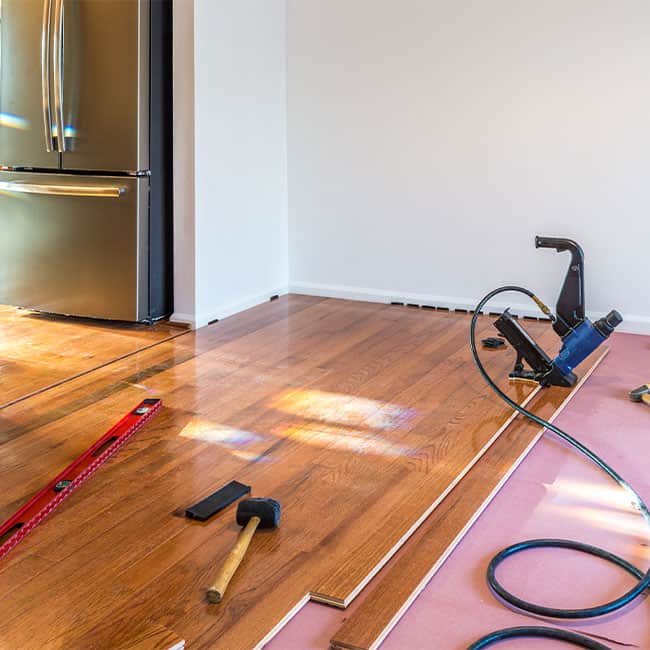
Even though most manufacturers claim that their laminate flooring is waterproof, a laminate plank will be damaged if it soaks water.
Laminate flooring is not an ideal solution for kitchens or bathrooms, because the distance between two neighboring planks is wide enough to allow water to seep through and reach the core layer made of fiberboard that swells once it soaks up water.
Spilling water over laminate flooring won’t damage it if the water is collected relatively quickly. Laminate flooring absorbs low-velocity impacts, and it is scratch-resistant, which makes it an excellent option for homeowners that have pets.
It is worth noting that this type of flooring will wear out in time, and once it does, you will have to replace it because refinishing isn’t an option.
Reliability
The durability of laminate flooring often depends on the price range, so the models that cost around $1 per square foot aren’t designed to last longer than a decade.
The majority of mid-range laminate flooring options that cost between $2.50 and $4 are durable enough to last for up to 15 years, while high-end models that are priced at $5 per square foot can remain in good condition for more than two decades.
Maintaining a laminate floor is a simple process that doesn’t require you to do much more other than vacuuming and mopping. You should keep in mind that you have to use unique cleaning products that protect the top layer and that exposure to hot steam can damage the floor permanently.
Engineered hardwood flooring – Pros and Cons
Pros
- Long lifespan
- The top layer is made from natural wood
- Suitable for high and low traffic areas
- Maintains visual properties of hardwood flooring options
Cons
- Installation can be expensive
- Hardwood flooring costs slightly less than hardwood flooring
Laminate flooring – Pros and Cons
Pros
- Quick and easy installation
- Scratch and impact resistant
- Minimum maintenance requirements
- Great for commercial and residential use
Cons
- Not a realistic replica of a hardwood floor
- Sanding or refinishing laminate flooring isn’t possible
The best alternatives to the engineered hardwood and laminate flooring
Although the numerous advantages these two flooring types offer make them an attractive option for homes and offices, other flooring types could be better suited for the space you’d like to cover.
Laminate flooring doesn’t look as visually appealing as the flooring options made from natural materials, while the maintenance requirements of engineered hardwood make it a poor choice for homeowners that don’t want to spend a lot of time on keeping their floors in good condition.
We’ve shortlisted some of the best alternatives to the engineered hardwood and laminate flooring so let’s take a closer look at their features.
Hardwood flooring
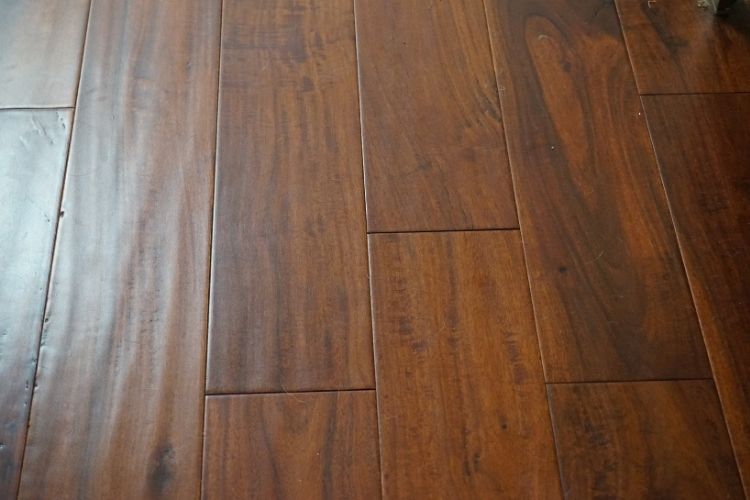
The exceptional durability, visual appeal, or the ability to refinish multiple times are some of the reasons why hardwood flooring is widely accepted as the best flooring solution on the market.
You can choose from a broad spectrum of wood species, and each of them has different hardness levels, water-resistance capacities, or maintenance requirements. Installing this type of flooring is a challenging task for inexperienced DIYers, and it commonly involves hiring a professional.
This flooring type can be expensive, and it might be a poor choice for projects with limited budgets.
Vinyl plank flooring
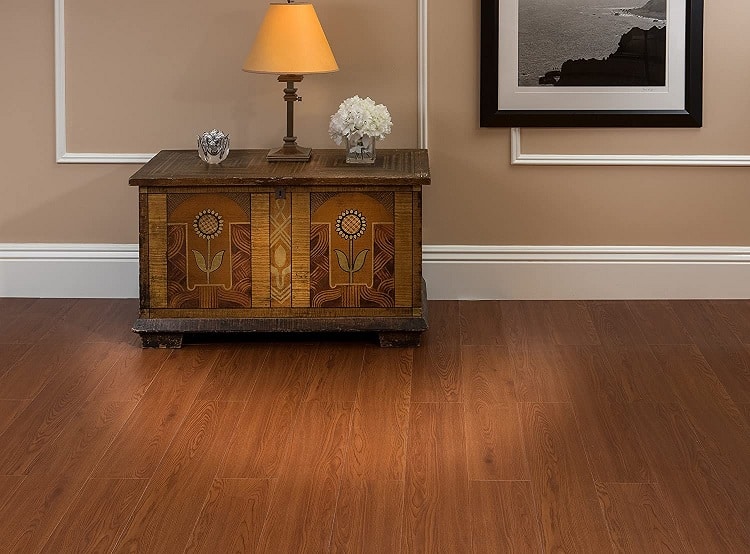
Spending a small fortune on a flooring project isn’t necessary since vinyl plank flooring options enable you to make an elegant floor at an affordable price. You can choose between LVP, WPC, and SPC vinyl flooring types that have a slightly different set of features.
You should opt for the WPC option if you’re installing flooring in a bathroom or a basement, while an LVP model is better suited for a living room or bedrooms. Go through our guide to the best COREtec flooring solutions if you want to find out more about these vinyl flooring planks and tiles.
Ceramic tile flooring
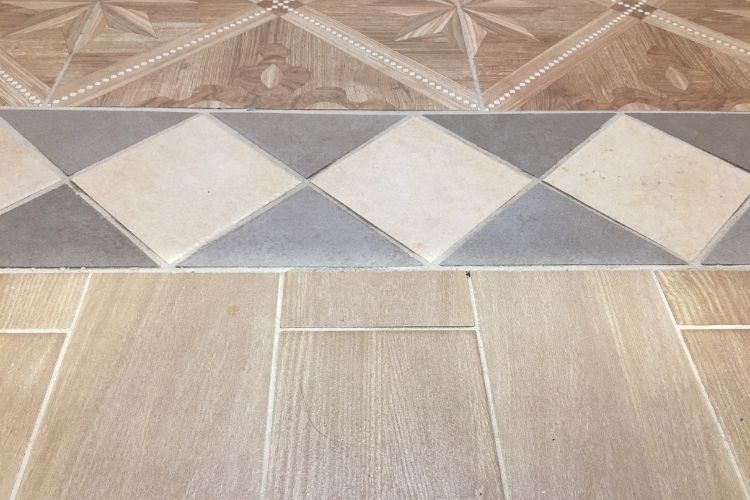
Going through the water-resistance specifications of each flooring model that attracts your attention can be tiring, so opting for a ceramic tile flooring solution can be an easier choice if you want to install flooring in your bathroom or kitchen.
Their hard surface makes them a great fit for high traffic areas, and it doesn’t attract a lot of dust or dirt, so you don’t have to spend a lot of time cleaning the tiles. Also, the immense selection of patterns and designs enables you to choose the model that matches the room’s style.
Ceramic tile flooring can be too cold for people who live in cold climates and the installation process might be too difficult for DIYers. Check out our guide to the best tile flooring options for more information about materials used to produce this type of flooring.
Frequently asked questions about engineered hardwood and laminate flooring
Answer: You must remove the current floor and prepare the surface by applying the preparation materials and adhesives before laying out the hardwood flooring.
Answer: Each engineered hardwood flooring model is different, but on average it takes 48 hours for the material to acclimate.
Answer: The top layer of laminate flooring contains aluminum oxide that prevents fading, but despite this direct sunlight exposure for several hours per day will cause discoloration over time.
Answer: Installing new laminate planks is your only option if you spotted bubbling or buckling in the old ones because sanding will destroy their protective top layer.
Our Verdict: Is laminate a more practical flooring option than engineered hardwood?
A large number of factors can affect which type of flooring you’re going to choose for your next home renovation project.
The size of the area you want to cover or the purpose for which that area is used are some of the factors that can help you determine if you should opt for laminate or engineered hardwood flooring.
From the standpoint of maintenance, affordability or how difficult is the installation process, there is no doubt that laminate flooring is the more practical choice. However, this material doesn’t have the visual appeal or the durability of the engineered hardwood flooring options.
Which of these flooring types are you going to choose? Let us know in the comments or continue reading our guide to the different types of flooring if you need assistance choosing flooring for your home renovation project.
There are plenty of budget generic flooring options, but for higher quality (and sometimes harder to find) premium flooring LL Flooring is a step up. Best of all, you can browse online for selections you may not find in your local Home Depot and have them safely delivered to your residence or job site.

